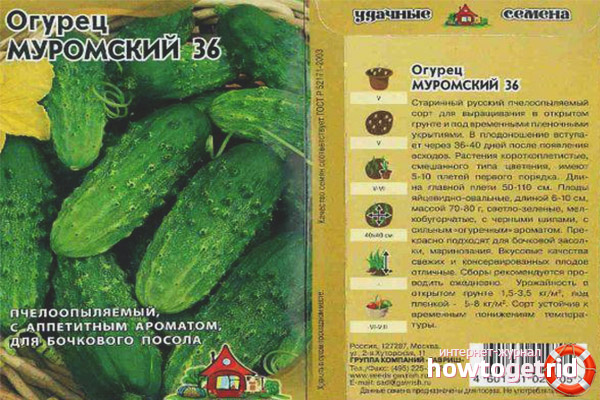The content of the article
The Muromsky cucumber variety has been grown since the 13th century and is one of the most ancient representatives of this culture. Its popularity is growing every year, thanks to the characteristics of the variety, taste and fast ripening of fruits.
Grade Features
The Muromsky variety belongs to early ripening plants. Rapid seed germination is noted, and the collection of the first, ripe green greens begins already a month after the appearance of the first leaves of the bush.
Bushes are distinguished by a large number of medium-sized leaves. Tops are evenly painted in a bright, rich shade of green. The plant is able to grow to 1.5 and in length. To simplify the process of collecting fruits, experienced vegetable growers advise tying the bush to a support or net.
The fruits are distinguished by an elongated, oval shape. Their skin is covered with small tubercles and painted in a light, green color with sparse stripes of white. On the surface of the tubercles, black spikes and slight pubescence can be seen. The average length of Zelentsy is from 6 to 8 cm, and the weight of each of them does not exceed the mark of 75 g.
The fruits of the Muromsky variety are elastic and juicy. The pulp is painted in a light green tint and a small amount of seeds that are not felt when eating cucumbers.
Muromsky variety gives an average amount of yield. From 1 square meter, vegetable growers collect 3 kg of mature greenery. A small number of fruits is compensated by their rapid ripening, which is completely satisfied with vegetable growers cultivating this variety for many years.
Growing Features
The Muromsky variety grows well and bears fruit in any conditions. It is allowed to grow on unprotected beds and in a closed greenhouse. Agronomists recommend early germination of seeds, adhering to the classical scheme:
- Seed disinfection. Disinfection of seed is necessary to prevent the development of harmful microorganisms that can lead to the death of young plants. It is carried out with the help of special, disinfectant preparations, which can be purchased in specialized stores or made independently. Many summer residents disinfect the seeds by soaking them in a weak solution of manganese for 1-2 hours.
- Growth stimulation. In order to achieve the maximum percentage of germination, the seeds are soaked in growth stimulants and root formation. They are not able to adversely affect the quality or taste of the fruit, and are considered safe chemicals that are quickly removed from the plant.
- Soil selection. The Muromsky cucumber variety is not a demanding representative of this culture. However, it is best grown in loose soil, rich in nutrients.
- The choice of containers. Most growers germinate seeds in peat pots. This ensures that the root system is maintained during transplantation. Neglect of this rule can lead to partial or complete breakdown of the roots, which is a common cause of death of young plants.
- Planting seeds. Seeds are placed in a container with nutrient soils to a depth of 1-1.5 cm. Sowing seeds in cold soil is not allowed. This will lead to the death of seed.
- Greenhouse conditions. Before the first shoots appear, the containers are covered with a thick film or thick glass. This creates favorable conditions for seed germination.
- Lighting. Seedlings need bright, diffused light. If necessary, it is acceptable to highlight young plants with phytolamps.
- Watering. Moderate watering should be carried out as the topsoil dries. Excessive moisture can cause rotting of the root system and death of young plants.
- Stable temperature. The temperature for seed germination should be at least +20 degrees Celsius.
Planting seedlings in open ground is carried out after setting a stable temperature regime. Experienced vegetable growers recommend replanting young bushes in the evening or on a cloudy day. This will help prevent burns on immature leaves.
Care

The Muromsky variety belongs to unpretentious plants, however, for normal fruiting and plant development, it is necessary to follow the standard rules for caring for this crop:
- Regular watering.
- Loosening the soil.
- Timely weed removal.
- Systematic fertilization.
- Regular preventive treatment for common diseases.
- Timely collection of ripe fruits.
- Compliance with simple rules of care ensures a good harvest.
Grade diseases
During the period of flowering and fruit formation, only folk remedies are allowed. One of the most common methods that are allowed during this period is a soap solution.
Diseases such as powdery mildew and cucumber bacteriosis can be dangerous for this variety. Agronomists recommend regularly inspecting the bushes for diseases and regularly conduct preventive treatment. Timely measures taken will help preserve the plant.
Muromsky variety can be found in many summer cottages in all climatic regions. It is very popular among beginning summer residents due to its simple care, which even a person with no experience in growing this crop can handle.
Video: Muromsky 36 cucumbers










Submit